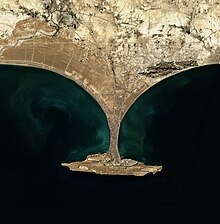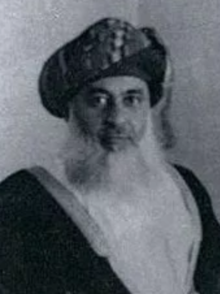Gwadar Purchase
Pakistan was able to acquire 15,210 square kilometres (5,870 sq mi) of land on the coast of Balochistan for around 5.5 billion Pakistani rupee (or 2 million US dollars today), paid mostly by Aga Khan IV.
[1][2] The local life in Omani Gwadar was mainly around fishing, trade, and agriculture, with the Baluchi tribes forming the primary community, living in a mix of traditional mud-brick homes, and relying on the sea for their livelihood, while also engaging in regional commerce that connected them to Oman, India, and East Africa.
Despite Taimur Sultan's eventual recovery of power in Muscat, the Omani administration continued to hold sway over Gwadar through the appointment of local governors.
Nevertheless, Pakistan started to indicate interest in Gwadar after it acquired control of various Baloch territories, including the Chief Commissioner's Province of British Baluchistan, as well as the states of Kharan, Makran, Lasbela and Kalat.
Upon receiving this information and with the backing of the local inhabitants, the Pakistani government made a formal request to the Sultan of Oman and Muscat to permit Gwadar to join Pakistan.
[1][7] As per the agreement, in the event that oil was discovered in Gwadar in commercially viable amounts, the Pakistani government would have to pay a percentage of the total revenue to the Sultan.
The deal also included provisions for the residents of Gwadar to retain their Omani citizenship without jeopardizing their rights as Pakistani citizens, the recruitment of Gwadar residents into the Sultan's Armed Forces, the opportunity for military personnel to receive training in Pakistani technical schools, the extradition of deserters to Oman, and the unrestricted export of rice to Oman at regular trade rates.
I welcome the residents of Gwadar into the Pakistani union and I would like to assure them that they will enjoy equal rights and privileges along with all other Pakistan nationals irrespective of considerations of religion, caste or creed.
The region’s national status was that of an overseas outpost of the Omani Empire, and it served as an important center for maritime trade, particularly between Oman, the Indian subcontinent, and East Africa.
The population was relatively small, with much of the local life revolving around the port, which served as a hub for the export of fish, dates, and pearls, as well as the import of goods from India, Persia, and beyond.




